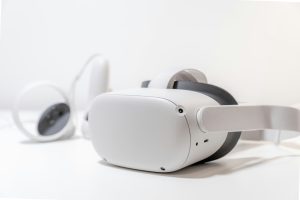How can you effectively use a VR stand-up platform?
How can you effectively use a VR stand-up platform?
Imagine stepping into a world where your training sessions feel like an exhilarating stand-up comedy show, only instead of jokes, you’re delivering presentations or honing skills. Welcome to the realm of VR stand-up platforms! These innovative tools are transforming how we learn, collaborate, and grow in professional settings. With immersive experiences at our fingertips, it’s time to explore how these platforms can elevate your work life and beyond. Ready to take a virtual leap? Let’s dive into everything you need to know about harnessing the power of a VR stand-up platform effectively!
What is a VR stand-up platform?
A VR stand-up platform is an immersive virtual reality environment designed for various professional applications. It allows users to engage in activities such as presentations, workshops, or training sessions while standing in a simulated space.
These platforms utilize advanced technology, including headsets and motion-tracking devices. This creates an interactive setting that mimics real-life scenarios. Participants can feel as though they are addressing an audience or collaborating with colleagues from anywhere in the world.
The experience often includes customizable environments where you can choose your backdrop—from a bustling conference room to a serene outdoor setting. This flexibility enhances creativity and engagement during sessions.
As remote work becomes more prevalent, VR stand-up platforms offer unique solutions for team building and skill enhancement without geographical barriers. They bridge gaps between physical presence and virtual interaction like never before.
The Benefits of Using a VR Stand-Up Platform
Using a VR stand-up platform transforms how we engage with training and presentations. It creates an immersive environment that feels real, enhancing focus and retention.
Participants can interact in a virtual space that mimics actual scenarios. This leads to improved understanding of complex subjects or skills.
Comfort is another advantage; users can practice from anywhere without the pressure of a live audience. This reduces anxiety and allows for experimentation.
Collaboration becomes seamless as teams connect across distances. The shared experience fosters communication and camaraderie.
Data tracking in these platforms helps assess performance effectively. Feedback is instant, allowing for quick adjustments in techniques or approaches.
The novelty of VR captures attention like traditional methods cannot. Engaging visuals stimulate interest, making learning not just effective but enjoyable too.
How to Set Up and Use a VR Stand-Up Platform
Setting up a VR stand-up platform is simpler than it seems. Begin with choosing the right space in your home or office. Make sure there’s enough room to move freely without hitting furniture or walls.
Next, follow the manufacturer’s VR Stand-Up Platform User Guide instructions for assembly. This typically involves connecting sensors and ensuring they’re positioned correctly for optimal tracking.
Once everything is connected, download any necessary software on your VR headset. Calibration is key here; take your time to adjust settings so that the experience feels immersive and comfortable.
When you’re ready to start using the platform, pick an engaging program suited for what you hope to achieve—whether it’s training simulations, team meetings, or creative brainstorming sessions.
Always familiarize yourself with controls before diving into activities. A few minutes of practice can make all the difference in enjoying your VR experience fully.
Tips for an Effective VR Stand-Up Experience
To enhance your VR stand-up experience, start by ensuring a clutter-free space. A clean environment reduces distractions and helps immerse you in the virtual realm.
Next, prioritize comfort. Choose supportive footwear and clothing that allows for movement without restriction. You want to feel free to express yourself fully while engaging with your audience.
Practice is key. Familiarize yourself with the platform’s features beforehand. The more comfortable you are with the technology, the smoother your performance will be.
Engage with your audience dynamically. Use hand gestures and facial expressions to convey emotions, making it easier for viewers to connect with you.
Embrace feedback from peers or mentors after each session. Constructive criticism can provide valuable insights into improving future performances on a VR stand-up platform.
Utilizing Virtual Reality for Professional Development and Training
Virtual reality is transforming professional development and training in remarkable ways. It allows employees to immerse themselves in realistic scenarios, fostering engagement and retention of information.
With VR, learners can practice skills in a safe environment. This hands-on approach makes complex tasks more approachable. Industries like healthcare and aviation have already embraced these technologies for simulations that mirror real-life challenges.
Moreover, virtual environments enable remote team members to collaborate effectively. They can engage with each other as VR Standing Platform if they are physically present, enhancing teamwork despite geographical barriers.
Feedback loops within VR platforms help users track their progress over time. This immediate assessment aids in identifying areas needing improvement without the pressure of traditional assessments.
As companies increasingly recognize its potential, VR is poised to reshape how we approach training and skill acquisition across various sectors.
Challenges and Limitations of VR Stand-Up Platforms
VR stand-up platforms offer innovative experiences, but they come with their own set of challenges. One major issue is the cost. High-quality VR equipment can be expensive, making it less accessible for some users.
Technical glitches can also hinder performance. Lagging or poor connectivity disrupts the immersive experience and may frustrate participants. Additionally, not all environments are conducive to VR use; space constraints can limit movement and interaction.
Another significant challenge is user comfort. Prolonged use of VR headsets can lead to discomfort or motion sickness in some individuals, impacting their engagement levels.
Content availability remains a concern. While there are many great options out there, finding specific training materials tailored to individual needs might still require additional effort and research from users seeking specialized information.
Conclusion: The Future of Virtual Reality in the Workplace
As we look ahead, the potential of VR stand-up platforms in the workplace appears boundless. These innovative tools are not just a passing trend; they represent a significant shift in how we approach training and development. With VR technology continuously improving, businesses will find even more ways to harness its power.
The immersive experience that virtual reality offers can lead to enhanced engagement among employees. This can result in better retention of information and improved performance on tasks. As companies invest in this technology, it’s likely we’ll see an increase in creative applications across various industries.
Moreover, as remote work becomes more prevalent, VR stand-up platforms may bridge the gap between physical presence and virtual interaction. Teams scattered across different locations could come together seamlessly for meetings or training sessions. The ability to interact within a shared space makes collaboration feel much more tangible.
Organizations must remain adaptable and open-minded about integrating these new technologies into their operations. Embracing VR could set them apart from competitors who stick with traditional methods.
The future holds exciting possibilities for those willing to explore what VR has to offer. The landscape is changing rapidly, and staying ahead means being proactive about incorporating advancements like VR stand-up platforms into everyday practices at work.



